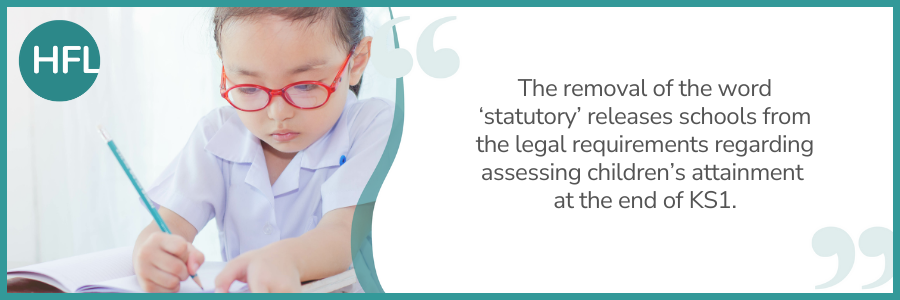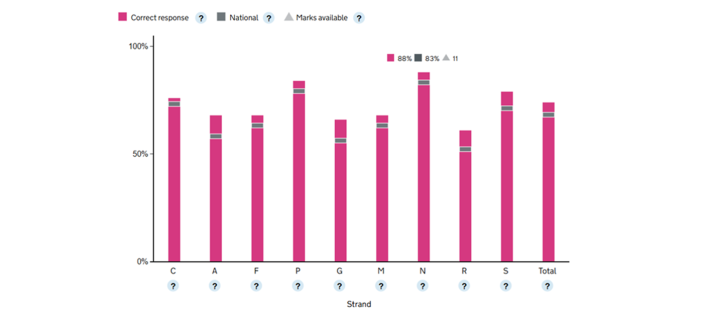
We have often heard the old saying that ‘the only constant in life is change’, so it should come as no surprise that we are starting this academic year with big changes to Key Stage 1 assessment and how we will calculate progress over the primary phases.
The headline is that end of Key Stage 1 assessment is no longer statutory and that the Reception Baseline Assessment will take its place as the basis for cohort level primary progress calculations. (The first results we will see from these calculations will be in 2028 when the first RBA cohort reach the end of Key Stage 2. We currently have no details on how this calculation model will work.)
What this means for Year 2 teachers
The removal of the word ‘statutory’ releases schools from the legal requirements regarding assessing children’s attainment at the end of KS1. Schools will no longer have to:
- assess pupils using SATs tests
- form teacher assessment judgements using the teacher assessment frameworks (TAFs)
- be externally moderated (unannounced Phonics Screening Check monitoring visits will still happen)
- report an end of KS1 standard to parents (although, schools still must report a phonics result if a child took the PSC in Year 2)
- report end of KS1 data to the local authority/HFL (there will not be any requests for optional/voluntary reporting of data from us).
So, what now?
Is this going to be a new dawn – a brave new world of assessment – or will we carry on pretty much the same as before just without the Standards and Testing Agency (STA) looming overhead?
Well, if schools wanted do, it would be perfectly possible to do the latter. STA are going to continue to produce SATs tests in reading, maths and grammar, punctuation, and spelling (GPS). These will be for optional use. Paper copies of these tests will automatically be sent into schools (based on pupil numbers from the school census) unless schools opt not to receive any tests by declining them on the Primary Assessment Gateway. New tests will be created each year to the same specification as previously (this means that some schools will still need to be selected for the trialling of assessment materials) ensuring that the tests may (in STA’s own words), ‘continue to inform classroom practice and help schools understand where pupils need additional support as they transition into KS2’. There will also be the scaled score conversion released at the same time as usual. Guidance for administering the optional tests will also be updated and released this term. The recommendation will be that if schools choose to use the tests, they use them in May to ensure that the scaled score conversions are meaningful. Of course, schools don’t have to follow this recommendation at all.
In a similar vein the existing TAFs will remain available on GOV.UK for optional use to support teacher assessment judgements. They remain a ‘secure fit’ document and would be about looking at a child’s performance in the test (reading and maths) alongside the assessment evidence collected/seen in everyday classroom practice and independent work.
Schools may choose to continue using the STA materials indefinitely or just for this year as they transition to something else. From an Assessment Team perspective, we are pretty agnostic about how a school chooses to proceed. There are clearly benefits to using the STA resources, not least that they are free and of a reliable standard (tests created professionally to ensure effectiveness and reduce bias etc). In the financial climate that schools find themselves in, it would seem prudent to use what is freely available rather than buying into other, often expensive, products. However, some schools may already subscribe to these sorts of products for other year-groups, and so expanding their use to Year 2 could make sense for internal tracking.
With regards to the TAFs, it may be that schools feel that they give a good summary of key curriculum milestones for the end of KS1 and that they are clearly understood by Y2 and 3 teachers, easing transition and creating a clear starting point for KS2. If this is the case, it really could make sense to stick with them at least until a similarly clear set of criteria can be shared in their place. This could also be useful for where schools would like to be able to moderate together and maintain a shared language, whether with HFL, or as part of more locally arranged clusters. However, it may be that schools would prefer to develop their own assessment criteria, based on their own curriculum, or purchase commercially developed criteria. Provided these are clear and appropriately ambitious, they could be just as useful as the TAFs.
Of course, it would be possible to proceed without any specific assessment materials at all (STA tests or other products) – after all, there is no requirement to assess specifically at the end of KS1 and surely, by following the national curriculum, we would be covering what we ‘need’ to and then with effective formative assessment and responsive teaching, teachers could be keeping track of what is secure and where gaps are. Alongside effective cross-year moderation, transition could be supported perfectly adequately.
Saying that, we know that most schools would want some form of summative assessment to enable a form of tracking of progress as a child moves from one year-group and key stage to another. This could of course be through good teacher assessment in any form. If a school was thinking of changing to a different method of assessment, we would encourage a consideration of some key points and principles:
- assessment should be meaningful – what assessment information is truly useful at the end of a key stage and what would support transition?
- assessment activities or tasks should be relevant to the curriculum content that has been taught – especially worth bearing in mind if purchasing assessment materials – do they fit your curriculum?
- assessment should be age-appropriate and sensitive to the needs of the child – relying on summative tests can be trickier with all, but especially young children, where teacher assessment based on a range of evidence gathered over time can create a more holistic picture
- assessment data should be honest, accurate and reliable – particularly important given that this needs to be a picture of a child’s attainment and also areas of development as they move into Year 3
- assessment data is more likely to be honest and reliable when it is used purely for informing next steps in learning or identifying key priorities, not for performance management of individuals.
When it comes to reporting to parents, ‘normal’ non-statutory year-group rules would apply. Schools would need to report general information about a child’s progress in each area of the national curriculum, but there would be no obligation to report a particular standard. This certainly gives a nice opportunity for us to reflect on current reporting styles within our schools. Many schools go far beyond the legal requirements and include ‘standards’ (e.g., ‘EXS’, ‘ARE’, or other level-alternatives) for all year-groups and sometimes all subjects. In terms of what is useful for parents, I often wonder how much sense the labels/standards we share really make if parents aren’t familiar with what they mean, but this may be a thought possibly worth exploring in a future blog.
With the removal of any requirements regarding reporting data to the local authority and any external moderations, schools may feel that it could be tricky to validate or confirm their assessment judgements or compare their assessment outcomes to those of other schools/national picture. For schools where KS1 assessment formed a big part of their data, such as infant or first/lower schools, this may be felt particularly strongly, although based on conversations with all-through primary schools, it seems they too have an appetite for some way to reliably and comparatively assess this end of key stage.
Given this, we will still be offering schools the option to book Year 2 moderations, where we can continue to use professional discussion to confirm assessment judgements. These could be in the summer term, as they have been previously, or indeed take a more formative form and take place earlier, e.g. in the spring term, to inform next steps in teaching. They could even be transition-focussed with Year 2 and 3 teachers involved in the dialogue. And of course, we will still be offering our Year 2 clusters, just as we will for all other year-groups (details can be found in our brochure).
We also have training available for using the optional materials from the Standards and Testing Agency that can be booked here, but also have plenty of support available for developing responsive teaching if schools wanted to shift away from focussing more on summative assessment.
At this point it would be remiss of me to not mention that our fabulous Primary Maths and English teams have developed resources to support assessment for KS1 (and beyond). For maths, you may want to explore the Essentials diagnostic assessment resources or the end of KS1 maths assessment toolkit (available within PA+). For English, the KS1&2 Reading Toolkit is very useful indeed, as is the KS1&2 Writing Toolkit (also available within the PA+ subscription).
If this has got all things assessment and moderation on your mind, it could be a good time for me to flag up the start of our familiar moderation cluster cycle. We are getting going with Year 6 clusters after the October half-term. There will be in-person sessions around the county as well as a couple of remote options.
Hopefully this blog has offered some useful information and thinking points for this shift in how we will be assessing Year 2. As usual, if you want to get in touch to chat or have any queries, please do – hfl.assessment@hfleducation.org



